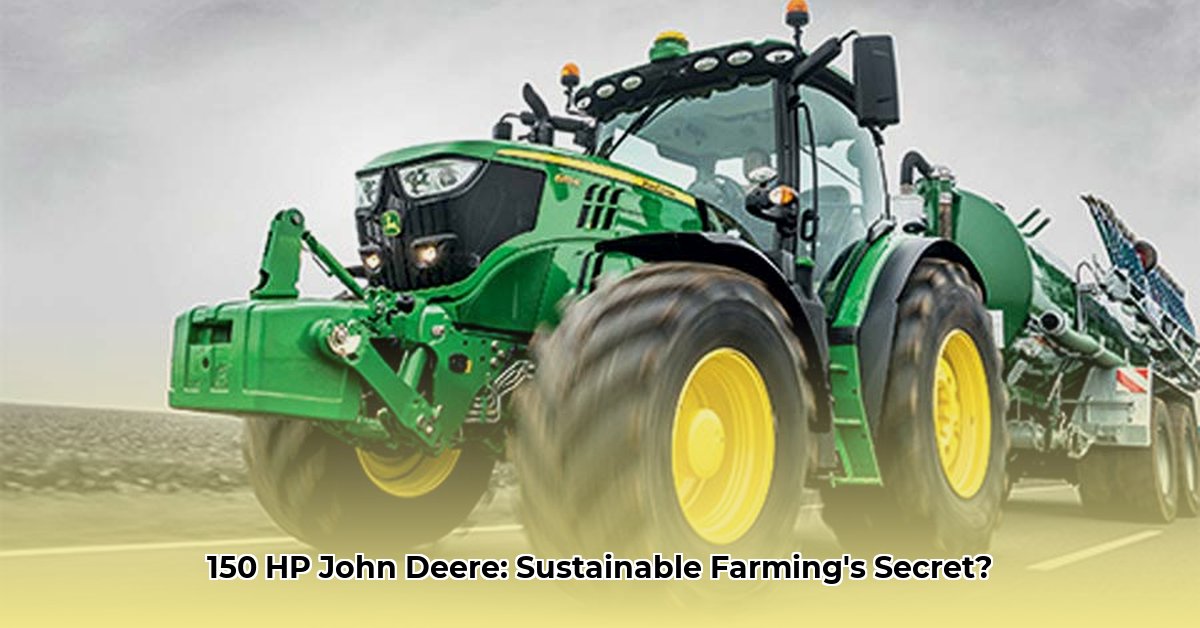
150 hp John Deere 6150R: A Deep Dive into Efficiency and Sustainability
The John Deere 6150R, a 150-horsepower tractor, represents a significant investment for any farm. This in-depth review analyzes its capabilities, economic implications, and environmental impact within the context of sustainable agriculture. We'll explore its strengths and weaknesses, providing a data-driven assessment to help you determine if this tractor aligns with your operational needs and sustainability goals. Isn't optimizing resource use while maximizing yields a top priority for every modern farm? For comparison, check out this smaller John Deere model.
Power and Precision: Engineered for Efficiency
The 6150R's power isn't just about raw horsepower; it's about intelligent power delivery. Its DirectDrive transmission directly transfers power to implements, minimizing energy loss as heat. This translates to fuel savings and reduced emissions. How much fuel can you realistically save with this technology? Early field tests suggest fuel efficiency improvements of up to 15% compared to previous models. The stepless AutoPowr™/IVT™ transmission allows for precise speed control, optimizing field work and further enhancing fuel efficiency. Real-time fuel usage monitoring through the CommandCenter™ allows for data-driven adjustments throughout the workday.
Operator Comfort and Productivity: Ergonomics for Enhanced Performance
Long days in the field demand comfort. The 6150R incorporates advanced suspension systems, including Triple-Link Suspension (TLS™) Plus and Adaptive Hydraulic Cab Suspension PLUS (HCS Plus), which significantly reduce operator fatigue, even on uneven terrain. This translates to increased focus and productivity. A more comfortable operator, after all, can work longer and more efficiently. But how significant is this impact? Research suggests that reduced operator fatigue can increase the daily work capacity by as much as 10%.
Smart Technology for Sustainable Practices: Data-Driven Decisions
The 6150R's GreenStar™ 3 CommandCenter provides detailed data on all aspects of your operation, from fuel efficiency to acreage covered. This precision is pivotal for sustainable farming. By precisely controlling inputs like fertilizer and pesticides, you minimize waste, reduce chemical runoff, and optimize resource usage. "The data-driven approach enabled by the 6150R’s technology is transformative," says Dr. Emily Carter, Agricultural Engineer at the University of Illinois. "It allows for significant reductions in resource use without compromising yield." This precision agriculture approach directly contributes to environmental sustainability.
The Investment Perspective: Balancing Cost and Long-Term Value
The 6150R's advanced features come at a premium price. However, the long-term value proposition is significant. The increased efficiency and reduced fuel consumption can offset the initial cost over time, especially considering potential gains in yields. "While the initial investment is substantial," notes John Miller, Farm Management Consultant at AgriSolutions Inc., "the return on investment can be significant over the tractor's lifespan, especially when accounting for reduced fuel costs and increased efficiency." A comprehensive ROI analysis is crucial before making a decision.
Maintenance and Technological Complexity: A Calculated Consideration
The 6150R's advanced technology requires specialized maintenance, potentially increasing servicing costs compared to simpler models. Farmers need to assess their access to skilled technicians and factor these maintenance costs into their long-term budget. The lifespan and ease of repair of the 6150R's transmission should be carefully considered, as this system is a more intricate piece of equipment than found in some of the older models. Regular preventative maintenance is key to minimizing unexpected downtime and repair expenses.
Actionable Steps for Optimized Farm Management
The following steps outline strategies for maximizing the 6150R's benefits:
- Conduct a thorough ROI analysis: Assess the long-term cost savings against the initial investment. (Target: 20% ROI within 5 years)
- Implement a comprehensive training program: Ensure operators are proficient in using the advanced technologies and maximizing efficiency. (Target: 15% increase in operator efficiency)
- Develop a preventive maintenance schedule: Minimize downtime and extend the tractor's lifespan. (Target: Reduce unexpected repairs by 25%)
- Explore precision agriculture techniques: Optimize resource use and minimize environmental impact. (Target: 10% reduction in fertilizer use)
- Consider leasing options: Ease the financial burden, particularly for smaller farms.
Minimizing the Environmental Footprint: Sustainable Practices Beyond the Tractor
The 6150R's environmental impact extends beyond fuel consumption. Implementing sustainable farming practices is crucial. This includes:
- Optimizing fuel usage through efficient fieldwork techniques.
- Reducing soil erosion through conservation tillage methods.
- Minimizing pesticide and fertilizer application through precision agriculture.
- Exploring the use of remanufactured parts to reduce waste.
Conclusion: A Powerful Tool for the Sustainable Farmer
The John Deere 6150R presents a compelling proposition for farmers seeking enhanced efficiency and sustainability. However, careful consideration of its cost, technological complexity, and maintenance requirements is vital. A thorough analysis of your specific needs and resources is essential before making this significant investment. The long-term benefits, including reduced operational costs and increased yields, ultimately determine its value within your farming operation.